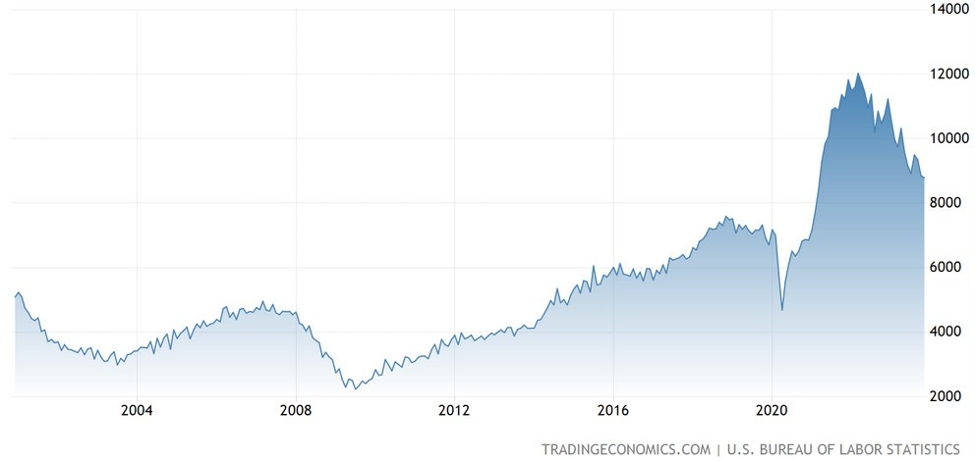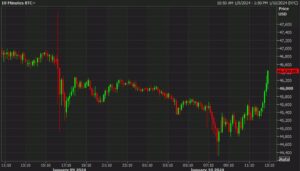
UPCOMING EVENTS:
- Tuesday: Japan
Unemployment Rate, Eurozone Q4 GDP, US Job Openings, US Consumer
Confidence. - Wednesday: BoJ
Summary of Opinions, Japan Industrial Production and Retail Sales,
Australia CPI, Chinese PMIs, Switzerland Retail Sales, UST Quarterly
Refunding Announcement, US ADP, Canada GDP, US ECI, FOMC Policy Decision. - Thursday: China
Caixin Manufacturing PMI, Switzerland Manufacturing PMI, Eurozone CPI,
Eurozone Unemployment Rate, BoE Policy Decision, US Challenger Job Cuts,
US Jobless Claims, Canada Manufacturing PMI, US ISM Manufacturing PMI. - Friday:
Australia PPI, US NFP.
Tuesday
The US December Job Openings are seen
falling to 8.750M vs. 8.790M prior. Job Openings have been falling steadily
since the peak in 2022 as the labour market continued to get into better
balance. As a reminder, the last
report surprised to the downside with both
the hiring and quits rate falling below the pre-pandemic levels. It will be
interesting to see how the Fed’s pivot and the aggressive easing in financial
conditions influenced the data.
US Job Openings
The US Consumer Confidence has been
falling steadily in the last quarter of 2023 amid a weakening labour market but
surprisingly jumped in December to levels last since in July. Compared
to the University of Michigan Consumer Sentiment, which shows more how the
consumers see their personal finances, the Consumer Confidence shows how the
consumers see the labour market.
The consensus sees the index increasing to 115.0 in January vs. 110.7 in December.
US Consumer Confidence
Wednesday
The Australian quarterly inflation
data is seen easing across all measures.
The CPI Y/Y is expected at 4.3% vs. 5.4% prior,
while the Q/Q reading is seen at 0.8% vs. 1.2% prior. The RBA is more
focused on the underlying inflation measures and those are expected to fall as
well. In fact, the Trimmed Mean CPI Y/Y is seen at 4.4% vs. 5.2% prior,
while the Q/Q figure is expected at 0.9% vs. 1.2% prior. We will also get the
Monthly CPI indicator which is expected to ease further to 3.7% vs. 4.3% prior.
The data will have no bearing on the February RBA meeting, but it will
influence the market’s pricing which currently expects the central bank to
start cutting rates in August.
RBA Trimmed Mean CPI YoY
The US Q4 Employment Cost Index (ECI) is
expected at 1.0% vs. 1.1% prior.
This is the most comprehensive measure of labour costs, but unfortunately, it’s
not as timely as the Average Hourly Earnings data. The Fed though watches
this indicator closely. Wage growth has been easing in the past two years,
but it still remains relatively elevated.
US Employment Cost Index
The Fed is expected to keep the FFR
unchanged at 5.25-5.50%. Given that the 3-month and 6-month annualised rates
are now below the 2% target, the central bank might also acknowledge the
progress by changing the line in the statement from “any additional policy
firming” to something like “sufficiently restrictive”. Beyond that we shouldn’t
see many changes and the attention will turn to the Press Conference where Fed
Chair Powell will be certainly questioned about the aggressive easing in
financial conditions since the December meeting, the falling inflation rate and
the change for their quantitative tightening policy.
Federal Reserve
Thursday
The Eurozone CPI Y/Y is expected at 2.8%
vs. 2.9% prior,
while the Core Y/Y measure is seen at 3.2% vs. 3.4% prior. The market
continues to expect the ECB to cut rates in April although the central bank
keeps on pushing back against such forecasts seeing the first cut coming in
summer. If the data continues to miss though, it will be very hard for the
ECB to maintain its patience. We will also see the latest Unemployment Rate
which is expected to remain unchanged at 6.4%.
Eurozone Core CPI YoY
The BoE is expected to keep the Bank Rate
unchanged at 5.25%. The data leading up to the meeting has been mixed with some
more cooling in the labour
market and wage growth but a surprisingly
hot CPI
report. Moreover, the Retail
Sales saw a big plunge in December while
the PMIs
improved in January. The central bank will likely maintain its patient
approach reaffirming that they will keep rates high for sufficiently long to
return to the 2% target.
BoE
The US Jobless Claims continue to be one
of the most important releases every week as it’s a timelier indicator on the
state of the labour market. Initial Claims keep on hovering around cycle
lows, while Continuing Claims after reaching a new cycle high started to trend
lower. This week the consensus sees Initial Claims at 210K vs. 214K prior,
while there’s no consensus for Continuing Claims although the prior release saw
an increase to 1833K vs. 1806K prior.
US Jobless Claims
The US ISM Manufacturing PMI is expected
at 47.3 vs. 47.4 prior.
Last week, the S&P
Global Manufacturing PMI
for January jumped back into expansion at 50.3, which was the highest reading
since October 2022. Maybe the recent
aggressive easing in financial conditions after the Fed’s pivot triggered a
renewed growth impulse and if that’s so, it will be hard for the market to
justify the six rate cuts currently priced for this year.
US ISM Manufacturing PMI
Friday
The US NFP is expected to show 173K jobs
added in January compared to 216K seen in December
and the Unemployment Rate to tick higher to 3.8% vs. 3.7% prior. The Average
Hourly Earnings Y/Y is expected at 4.1% vs. 4.1% prior, while the M/M measure
is seen at 0.3% vs. 0.4% prior. The last report had some notable underlying
weaknesses with the household survey for example showing the largest jobs
decline since April 2020 lockdown, so some more weakness under the hood might
start to unnerve the market.
US Unemployment Rate
- SEO Powered Content & PR Distribution. Get Amplified Today.
- PlatoData.Network Vertical Generative Ai. Empower Yourself. Access Here.
- PlatoAiStream. Web3 Intelligence. Knowledge Amplified. Access Here.
- PlatoESG. Carbon, CleanTech, Energy, Environment, Solar, Waste Management. Access Here.
- PlatoHealth. Biotech and Clinical Trials Intelligence. Access Here.
- Source: https://www.forexlive.com/news/weekly-market-outlook-29-02-february-20240128/
- :has
- :is
- :not
- :where
- ][p
- $UP
- 1
- 110
- 2%
- 2020
- 2022
- 2023
- 50
- 7
- 8
- a
- About
- acknowledge
- across
- added
- Additional
- adp
- After
- against
- aggressive
- All
- also
- Although
- Amid
- an
- and
- Announcement
- approach
- April
- ARE
- around
- AS
- At
- attention
- AUGUST
- Australia
- Australia CPI
- Australia PPI
- Australian
- average
- back
- Balance
- Bank
- Bank Rate
- BE
- been
- below
- Better
- Beyond
- Big
- BoE
- boj
- but
- by
- Canada
- Canada GDP
- Canada Manufacturing PMI
- central
- Central Bank
- certainly
- Chair
- challenger
- change
- Changes
- changing
- China
- chinese
- Chinese PMIs
- claims
- coming
- compared
- comprehensive
- conditions
- Conference
- confidence
- Consensus
- consumer
- consumer sentiment
- Consumers
- continue
- continued
- continues
- continuing
- Core
- Cost
- Costs
- CPI
- Currently
- Cut
- cuts
- cutting
- cycle
- data
- December
- decision
- Decline
- downside
- Earnings
- ease
- easing
- ECB
- elevated
- employment
- Eurozone
- Eurozone CPI
- Every
- example
- expansion
- expect
- expected
- expects
- fact
- Fall
- Falling
- February
- Fed
- Figure
- Finances
- financial
- First
- focused
- FOMC
- For
- forecasts
- from
- further
- GDP
- get
- given
- Global
- Growth
- had
- Hard
- Have
- High
- higher
- highest
- Hiring
- hood
- HOT
- household
- How
- HTTPS
- if
- important
- improved
- in
- Increase
- increasing
- index
- Indicator
- industrial
- Industrial Production
- inflation
- inflation rate
- influence
- influenced
- initial
- interesting
- into
- IT
- ITS
- January
- Japan
- Japan industrial production
- Job
- job cuts
- jobless claims
- Jobs
- jpg
- Keep
- Labour
- largest
- Last
- latest
- leading
- levels
- like
- likely
- Line
- lockdown
- Long
- Lows
- maintain
- manufacturing
- many
- Market
- market outlook
- maybe
- mean
- measure
- measures
- meeting
- Michigan
- might
- miss
- mixed
- monthly
- more
- Moreover
- most
- New
- nfp
- no
- notable
- now
- october
- of
- on
- ONE
- openings
- Opinions
- Outlook
- past
- Patience
- patient
- Peak
- personal
- Pivot
- plato
- Plato Data Intelligence
- PlatoData
- plunge
- pmi
- policy
- Powell
- ppi
- press
- pricing
- Prior
- Production
- Progress
- Pushing
- quantitative
- quantitative tightening
- Quarter
- quarterly
- Questioned
- Rate
- Rates
- RBA
- reaching
- Reading
- reaffirming
- recent
- relatively
- release
- Releases
- remain
- remains
- reminder
- renewed
- report
- retail
- Retail Sales
- return
- sales
- saw
- see
- seeing
- seen
- sees
- sentiment
- show
- showing
- Shows
- since
- SIX
- So
- some
- something
- start
- started
- State
- Statement
- steadily
- Still
- such
- SUMMARY
- surprised
- Survey
- switzerland
- Target
- that
- The
- their
- they
- this
- this week
- this year
- those
- though?
- tick
- tightening
- timely
- to
- Trend
- triggered
- TURN
- two
- under
- underlying
- unemployment
- unemployment rate
- unfortunately
- university
- University of Michigan
- University of Michigan Consumer Sentiment
- us
- US ISM Manufacturing
- US ISM Manufacturing PMI
- US job openings
- US Jobless Claims
- us NFP
- UST
- very
- vs
- wage
- was
- watches
- we
- weakness
- week
- weekly
- which
- while
- will
- with
- year
- years
- zephyrnet











